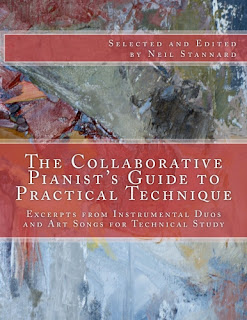 You can now have a look inside at Amazon!
You can now have a look inside at Amazon! From the introduction:
"Collaborative pianists need all the same technical skills required of soloists, and some would argue that they need to be able to play mezzo forte and under. If you doubt this, look at cello sonatas of Rachmaninoff and Chopin, violin and cello sonatas of Brahms and songs by Strauss and Wolf, all of which are contained in this volume along with all the other major composers of duo repertoire...
 I advise all pianists, including collaborative pianists, to put away Czerny and Hanon exercises and, regardless of technical approach, apply themselves to these passages from music they intend to play—collaborative works by master composers—as building blocks for technique and musicianship. Lessons learned here on the relationship of song text to expressive pianism are applicable to not just art song but to both instrumental duos and solo repertoire."
I advise all pianists, including collaborative pianists, to put away Czerny and Hanon exercises and, regardless of technical approach, apply themselves to these passages from music they intend to play—collaborative works by master composers—as building blocks for technique and musicianship. Lessons learned here on the relationship of song text to expressive pianism are applicable to not just art song but to both instrumental duos and solo repertoire."

